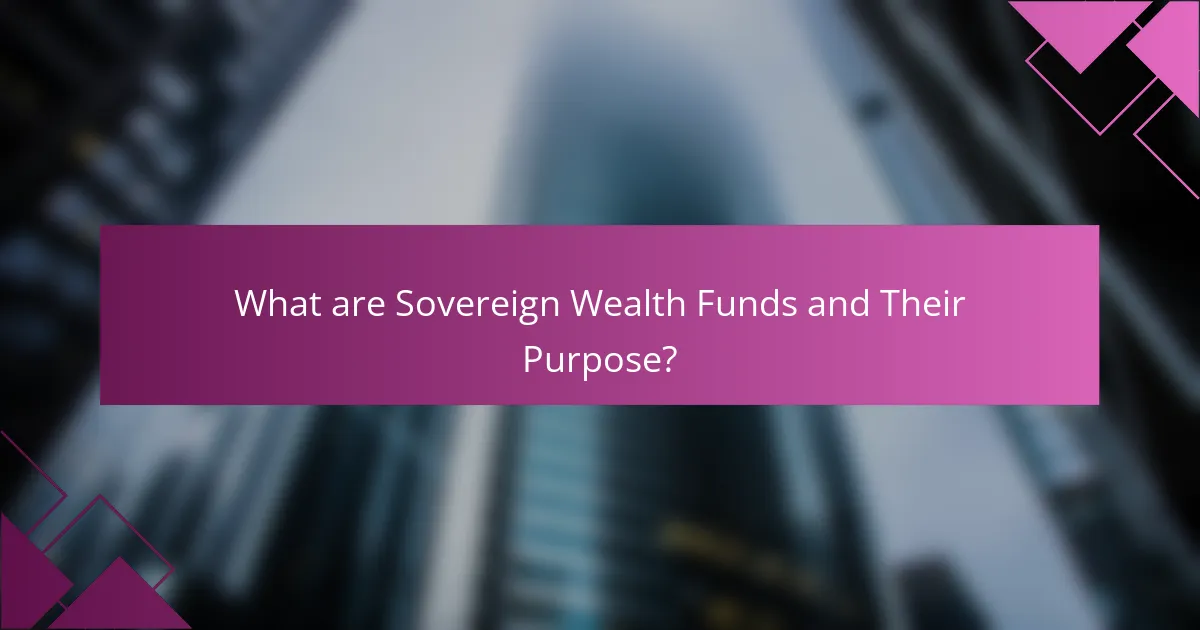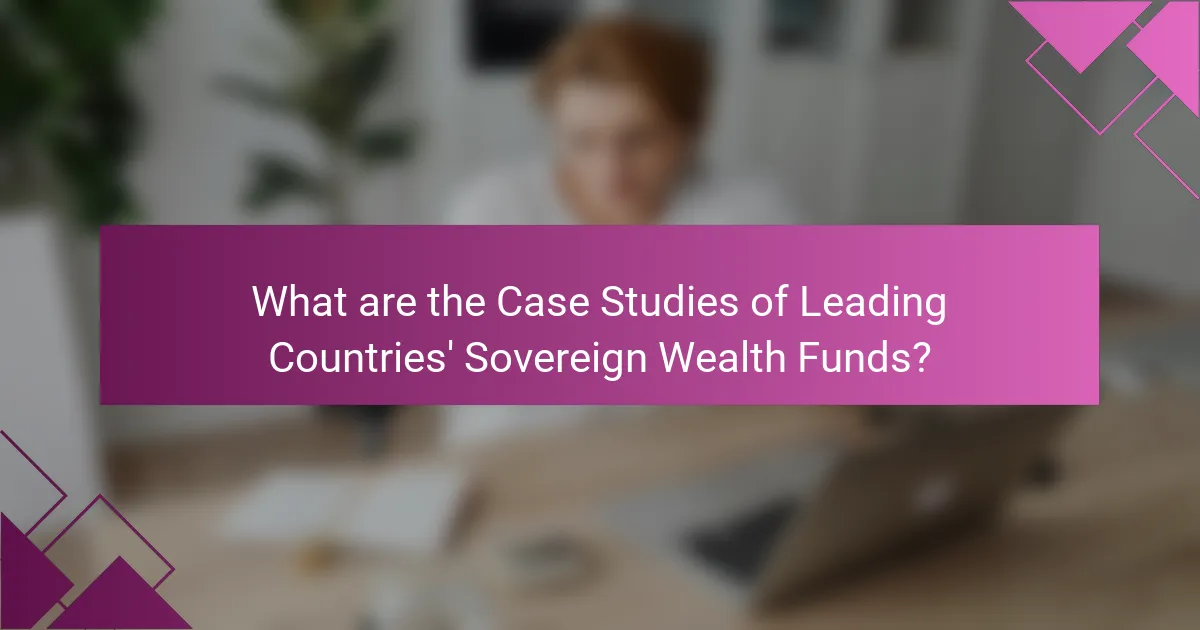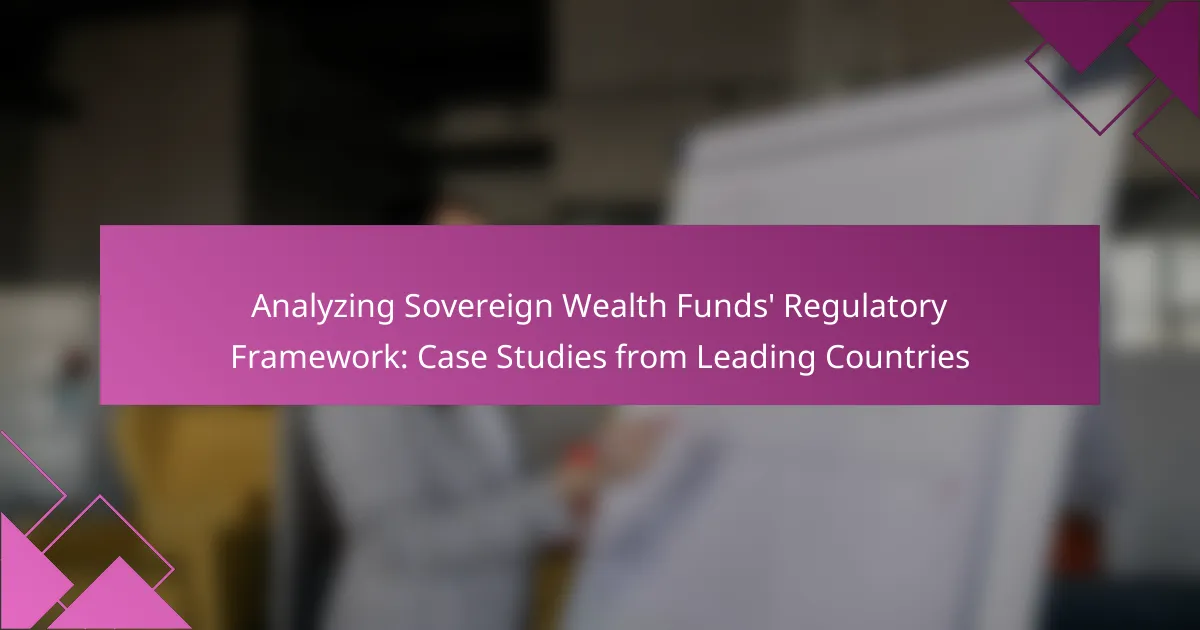
What are Sovereign Wealth Funds and their Purpose?
Sovereign Wealth Funds (SWFs) are state-owned investment funds or entities. They are created to manage a country’s reserves and investments. The primary purpose of SWFs is to achieve long-term financial returns. They invest in various asset classes, including stocks, bonds, real estate, and infrastructure. SWFs also help stabilize national economies during financial crises. For example, Norway’s Government Pension Fund Global is one of the largest SWFs, designed to secure wealth for future generations. As of 2023, global SWF assets exceed $10 trillion, reflecting their significant role in international finance.
How do Sovereign Wealth Funds operate within global finance?
Sovereign Wealth Funds (SWFs) operate as state-owned investment funds that manage national savings for various purposes. They invest in a diverse range of assets, including stocks, bonds, real estate, and infrastructure. SWFs aim to stabilize the economy, save for future generations, or fund specific projects. For instance, the Government Pension Fund of Norway is one of the largest SWFs, investing surplus revenues from the petroleum sector. SWFs also play a significant role in global finance by providing liquidity and capital to markets. In 2020, global SWF assets were estimated at over $9 trillion. Their investment decisions can influence market trends and corporate governance. Countries with SWFs often have specific regulations guiding their operations to ensure transparency and accountability.
What are the key components that define a Sovereign Wealth Fund?
A Sovereign Wealth Fund (SWF) is a state-owned investment fund. It is established to manage a country’s reserves for various purposes. Key components include funding sources, investment strategies, and governance structures.
Funding sources typically consist of surplus revenues from natural resources, foreign exchange reserves, or fiscal surpluses. Investment strategies may focus on diverse asset classes like equities, bonds, real estate, and alternative investments. Governance structures ensure accountability and transparency in decision-making processes.
For example, Norway’s Government Pension Fund Global is funded by oil revenues and invests globally. Its governance model emphasizes ethical investment and sustainability. These components collectively define the operational framework of SWFs across different nations.
How do the investment strategies of Sovereign Wealth Funds vary?
Sovereign Wealth Funds (SWFs) vary in their investment strategies based on their objectives, risk tolerance, and geographical focus. Some SWFs prioritize long-term growth and invest heavily in equities and real estate. For instance, Norway’s Government Pension Fund Global primarily focuses on sustainable investments and has a diversified portfolio. Other SWFs, like the Abu Dhabi Investment Authority, may pursue more aggressive strategies, including alternative investments and private equity.
Additionally, the investment strategies can be influenced by the fund’s origin. For example, funds from resource-rich countries often allocate a significant portion to commodities. In contrast, funds from developed nations may lean towards technology and innovation sectors.
Regulatory frameworks also play a crucial role in shaping these strategies. Countries with stringent regulations may limit the types of investments SWFs can pursue, affecting their overall strategy. For example, Singapore’s GIC adheres to a strict governance framework that influences its investment choices.
Ultimately, the variation in investment strategies reflects the unique goals and contexts of each Sovereign Wealth Fund.
What is the regulatory framework governing Sovereign Wealth Funds?
The regulatory framework governing Sovereign Wealth Funds (SWFs) varies by country. It typically includes laws, guidelines, and principles that dictate their operations. Many countries adopt the Santiago Principles, a set of guidelines established in 2008. These principles promote transparency, accountability, and good governance among SWFs.
Countries like Norway have specific legislation, such as the Government Pension Fund Act, which governs their SWF. Other nations implement regulations through central banks or finance ministries. Compliance with international standards is also a common requirement.
For instance, the International Monetary Fund (IMF) encourages adherence to these principles. This framework aims to ensure that SWFs operate in a manner that is beneficial to their economies.
What are the international standards for regulating Sovereign Wealth Funds?
International standards for regulating Sovereign Wealth Funds (SWFs) include the Santiago Principles. These principles were established in 2008 by the International Working Group of Sovereign Wealth Funds. They aim to promote transparency, accountability, and good governance in SWF operations. The Santiago Principles consist of 24 principles that guide the investment practices of SWFs. They emphasize the importance of legal frameworks, risk management, and ethical investment practices. Adherence to these principles is voluntary but widely recognized in the global financial community. Many countries with SWFs, such as Norway and Singapore, have adopted these principles to enhance their credibility.
How do different countries implement regulations for their Sovereign Wealth Funds?
Different countries implement regulations for their Sovereign Wealth Funds (SWFs) through various frameworks and guidelines. For instance, Norway’s Government Pension Fund Global operates under strict transparency rules and ethical guidelines. The fund publishes detailed annual reports on its investments and governance practices. In contrast, the United Arab Emirates has established a more flexible regulatory environment, allowing for significant discretion in investment strategies. Singapore’s GIC adheres to a framework that emphasizes long-term returns and risk management, guided by the principles of sustainable investment. Each country tailors its regulations to align with national interests, economic goals, and governance structures. Countries like Australia and Canada also have distinct approaches, focusing on accountability and performance metrics to enhance public trust. These regulations reflect the unique economic contexts and strategic objectives of each nation.

What are the Case Studies of Leading Countries’ Sovereign Wealth Funds?
Norway, Singapore, and the United Arab Emirates are leading countries with prominent sovereign wealth funds. Norway’s Government Pension Fund Global is the largest, with assets exceeding $1 trillion. It focuses on sustainable investments and adheres to ethical guidelines. Singapore’s GIC and Temasek Holdings manage substantial assets, investing in diverse sectors globally. GIC emphasizes long-term growth, while Temasek focuses on transformative technologies. The Abu Dhabi Investment Authority represents the UAE, managing over $700 billion in assets. It invests in various asset classes, including real estate and infrastructure. These case studies illustrate diverse investment strategies and regulatory frameworks across sovereign wealth funds.
How do the regulatory frameworks of Norway’s and Singapore’s Sovereign Wealth Funds compare?
Norway’s and Singapore’s Sovereign Wealth Funds have distinct regulatory frameworks. Norway’s Government Pension Fund Global operates under a transparent framework governed by the Ministry of Finance. It emphasizes ethical investment and sustainability criteria. The fund adheres to the principles of responsible management and has strict guidelines on exclusionary investments. In contrast, Singapore’s GIC operates with more confidentiality. The Monetary Authority of Singapore oversees it, focusing on maximizing returns without public disclosure of specific strategies. Both funds aim for long-term growth, but Norway prioritizes transparency and ethical considerations, while Singapore emphasizes strategic discretion. This difference reflects their respective national priorities in wealth management.
What lessons can be learned from Norway’s approach to Sovereign Wealth Fund regulation?
Norway’s approach to Sovereign Wealth Fund regulation offers several key lessons. First, transparency is crucial. Norway mandates regular public reporting on fund performance and investment strategies. This builds trust and accountability among citizens. Second, a clear investment strategy is essential. Norway focuses on long-term returns and sustainable investments. This approach mitigates risks associated with market volatility. Third, strong governance structures are vital. The fund operates under strict ethical guidelines and is managed independently from political influence. This separation enhances decision-making integrity. Lastly, stakeholder engagement is important. Norway involves citizens in discussions about fund usage, fostering a sense of ownership and responsibility. These lessons highlight the importance of transparency, strategy, governance, and engagement in effective Sovereign Wealth Fund regulation.
How does Singapore’s model of regulation differ from Norway’s?
Singapore’s model of regulation for sovereign wealth funds emphasizes a more market-oriented approach. This contrasts with Norway’s model, which is characterized by a strong focus on transparency and ethical investment. Singapore’s regulatory framework allows for greater flexibility in investment strategies. In comparison, Norway’s Government Pension Fund Global adheres to strict ethical guidelines and a clear set of investment principles. Singapore’s model promotes active management of assets, while Norway typically adopts a passive investment strategy. Furthermore, Singapore’s regulatory body, the Monetary Authority of Singapore, encourages innovation in financial services. Conversely, Norway’s Financial Supervisory Authority prioritizes adherence to established ethical standards. These differences reflect the unique economic contexts and policy objectives of each country.
What challenges do leading countries face in regulating Sovereign Wealth Funds?
Leading countries face several challenges in regulating Sovereign Wealth Funds (SWFs). One significant challenge is the lack of transparency in operations and investment strategies of SWFs. This opacity can lead to concerns about the potential for political influence and economic destabilization. Another challenge is the varying legal frameworks across countries, which complicates international cooperation and regulatory alignment. Additionally, the diverse objectives of SWFs, ranging from economic stabilization to strategic asset acquisition, create inconsistencies in regulatory approaches. Furthermore, there is a risk of regulatory arbitrage, where funds may exploit less stringent regulations in certain jurisdictions. These factors contribute to the complexity of establishing a cohesive regulatory framework for SWFs globally.
How do geopolitical factors influence Sovereign Wealth Fund regulations?
Geopolitical factors significantly influence Sovereign Wealth Fund (SWF) regulations. These factors shape the strategic objectives and investment behaviors of SWFs. For instance, countries may adjust regulations to respond to international sanctions or trade agreements. Political stability in a region can lead to more favorable regulatory environments. Conversely, geopolitical tensions may prompt stricter oversight and transparency requirements. Historical examples show that SWFs in politically volatile regions often face heightened scrutiny. Additionally, alignment with global economic policies can dictate investment strategies. Therefore, geopolitical dynamics play a crucial role in determining the regulatory landscape for SWFs.
What are the risks associated with inadequate regulation of Sovereign Wealth Funds?
Inadequate regulation of Sovereign Wealth Funds (SWFs) poses several risks. These risks include lack of transparency, which can lead to corruption and mismanagement. Poor governance structures can result in investments that do not align with national interests. Inadequate oversight may also facilitate political interference in fund operations. This can undermine the fund’s ability to generate sustainable returns. Moreover, insufficient regulation can expose economies to financial instability. For instance, unregulated SWFs may engage in excessive risk-taking. This behavior can lead to significant losses during economic downturns. Overall, the absence of a robust regulatory framework increases the potential for negative economic impacts.

How can countries improve their Sovereign Wealth Fund regulations?
Countries can improve their Sovereign Wealth Fund regulations by enhancing transparency and accountability. Implementing rigorous reporting standards can ensure that funds operate with clarity. Establishing independent oversight bodies can further monitor fund activities. Countries should also adopt best practices from successful models, such as Norway’s Government Pension Fund Global. This fund emphasizes ethical investment principles and sustainability. Regular audits can reinforce trust in fund management. Additionally, engaging stakeholders in decision-making can align funds with national interests. These measures contribute to more effective governance of Sovereign Wealth Funds.
What best practices can be adopted from successful case studies?
Best practices from successful case studies of sovereign wealth funds include transparency, governance, and strategic asset allocation. Transparency involves clear reporting and disclosure of fund activities. For instance, Norway’s Government Pension Fund Global publishes detailed reports annually, enhancing accountability. Governance structures should ensure independence and expertise. Singapore’s GIC employs a board with diverse backgrounds to guide investment decisions. Strategic asset allocation focuses on long-term returns while managing risks. The Abu Dhabi Investment Authority utilizes a diversified portfolio to stabilize performance across market cycles. These practices contribute to the effective management and sustainability of sovereign wealth funds.
How can transparency and accountability be enhanced in Sovereign Wealth Fund management?
Enhancing transparency and accountability in Sovereign Wealth Fund management can be achieved through several key strategies. Implementing standardized reporting practices is essential. This includes regular disclosures of financial statements and investment strategies. Adopting international best practices, such as the Santiago Principles, can guide these efforts.
Engaging independent auditors to review fund activities adds an additional layer of oversight. This ensures that fund operations are scrutinized by external experts. Establishing clear governance structures is also crucial. Defining roles and responsibilities within the fund helps to minimize conflicts of interest.
Incorporating stakeholder engagement can further enhance accountability. Involving the public and relevant stakeholders in decision-making processes fosters trust. Lastly, utilizing technology for real-time reporting can improve transparency. Digital platforms can provide accessible information to the public about fund performance and management decisions.
What role does international cooperation play in regulating Sovereign Wealth Funds?
International cooperation is essential in regulating Sovereign Wealth Funds (SWFs). It facilitates the establishment of common standards and best practices. These standards help ensure transparency and accountability in SWF operations. Collaborative frameworks, such as the Santiago Principles, promote responsible investment practices. They guide countries in aligning their SWF regulations with global norms. International cooperation also aids in addressing potential risks associated with SWFs. For example, it can mitigate concerns about geopolitical influence and market stability. Countries can share information and strategies to enhance regulatory effectiveness. This collective approach fosters trust among nations and supports global financial stability.
What are the future trends in Sovereign Wealth Fund regulations?
Future trends in Sovereign Wealth Fund regulations include increased transparency and accountability. Governments are focusing on establishing clear guidelines for fund operations. This shift aims to enhance public trust and mitigate risks. Additionally, there is a growing emphasis on sustainable investment practices. Many funds are integrating environmental, social, and governance (ESG) criteria into their strategies. Regulatory bodies are likely to adopt stricter compliance measures. This is to ensure funds adhere to international best practices. Furthermore, collaboration between sovereign funds and international organizations is expected to rise. This collaboration will help in harmonizing regulations across borders. These trends reflect a broader movement towards responsible and ethical investment.
How might technology impact the regulation of Sovereign Wealth Funds?
Technology can significantly enhance the regulation of Sovereign Wealth Funds (SWFs). Digital tools improve transparency and accountability in fund operations. Blockchain technology can facilitate real-time tracking of transactions and asset management. This reduces the risk of fraud and mismanagement. Data analytics allows regulators to monitor fund performance and compliance more effectively. Artificial intelligence can identify irregular patterns in fund activities. These advancements lead to more informed regulatory decisions. Historical examples show that countries adopting technology in finance see improved regulatory outcomes. For instance, the integration of technology in the financial sector has increased investor confidence in various markets.
What emerging global economic trends could influence Sovereign Wealth Fund frameworks?
Emerging global economic trends influencing Sovereign Wealth Fund frameworks include increased focus on sustainability and climate change. Many funds are integrating Environmental, Social, and Governance (ESG) criteria into investment strategies. This shift reflects a growing demand for responsible investing among stakeholders. Additionally, the rise of digital currencies and fintech is reshaping investment landscapes. Sovereign Wealth Funds are exploring blockchain technology for transparency and efficiency. Geopolitical tensions are also impacting investment decisions, prompting funds to diversify portfolios across regions. Lastly, the post-pandemic economic recovery is driving funds to reassess risk management strategies. These trends collectively shape the evolving frameworks of Sovereign Wealth Funds globally.
What tips can countries consider for effective Sovereign Wealth Fund management?
Countries can enhance Sovereign Wealth Fund management by implementing robust governance structures. Strong governance ensures accountability and transparency in decision-making processes. Countries should establish clear investment objectives aligned with national priorities. This alignment helps in achieving long-term economic stability.
Diversification of investment portfolios is crucial. A well-diversified portfolio reduces risks associated with market volatility. Regular performance assessments and audits enhance fund management. These evaluations ensure that funds are meeting their objectives and adhering to regulations.
Engaging in stakeholder consultations fosters public trust. Involving citizens in discussions about fund usage promotes transparency. Countries should also invest in capacity building for fund managers. Skilled managers can make informed investment decisions that align with the fund’s goals.
Finally, adopting best practices from successful funds globally can provide valuable insights. For instance, Norway’s Government Pension Fund Global is often cited for its effective management strategies.
Sovereign Wealth Funds (SWFs) are state-owned investment entities designed to manage national reserves and achieve long-term financial returns. This article analyzes the regulatory frameworks governing SWFs, highlighting case studies from leading countries such as Norway, Singapore, and the United Arab Emirates. Key components discussed include funding sources, investment strategies, and governance structures, as well as the challenges and future trends in SWF regulation. The article emphasizes the importance of transparency, accountability, and international cooperation in enhancing the effectiveness of SWF management.
